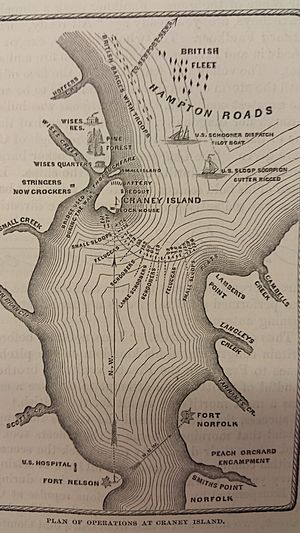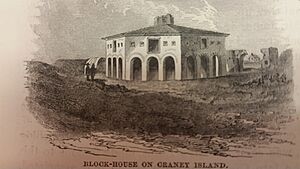Battle of Craney Island facts for kids
Quick facts for kids Battle of Craney Island |
|||||||
|---|---|---|---|---|---|---|---|
| Part of the War of 1812 | |||||||
 Battle of Craney Island |
|||||||
|
|||||||
| Belligerents | |||||||
| Commanders and leaders | |||||||
| Strength | |||||||
| 2,500 Infantry and Marines | 596 Infantry, Marines and Sailors 91 artillery pieces |
||||||
| Casualties and losses | |||||||
| 3 killed 16 wounded 62 missing |
None | ||||||
The Battle of Craney Island was an important victory for the United States. It happened during the War of 1812. This battle stopped the British from invading the cities of Norfolk and Portsmouth in Virginia. These cities were very important for American trade at the time.
Contents
Why the Battle Happened
British Plans for Attack
In early 1813, British Admirals Sir George Cockburn and Sir John B. Warren had a plan. They wanted to attack the Gosport Shipyard in Portsmouth. Their main goal was to capture the American warship, the U.S.S. Constellation.
American Defenses
General Robert B. Taylor led the Virginia Militia (a citizen army) in the Norfolk area. He quickly built defenses around Norfolk and Portsmouth. But he didn't want the British to get that far.
General Taylor had a smart idea. He used several ships to create a chain barrier. This barrier stretched across the Elizabeth River. It went between Fort Norfolk and Fort Nelson.
He also built a fort on Craney Island. This island was at the mouth of the Elizabeth River. The U.S.S. Constellation was stuck in the Chesapeake Bay because of the British blockade. So, its crew helped defend Craney Island. In total, 596 American soldiers, sailors, and marines defended the island.
The Battle Begins
British Landing Attempt
On the morning of June 22, 1813, the British attacked. About 700 British Royal Marines and soldiers landed on the mainland. This was west of Craney Island. When they landed, the American defenders saw they had no flag. The Americans quickly raised their own flag over their defenses.
The American defenders then opened fire. The British attackers realized they couldn't cross the water to the island. The American fire was too strong. They began to fall back.
Next, British boats tried to attack the eastern side of the island. These boats were full of sailors and more Royal Marines. Captain Arthur Emmerson commanded the American artillery (cannons) on this side.
Captain Emmerson told his gunners to wait. He wanted them to hold their fire until the British boats were close enough. Once they fired, the British attackers were driven away. Some of their boats were even destroyed. The British then retreated back to their ships.
What Happened Next
American Victory
The Americans had won a great defensive victory. They faced a much larger British force. Norfolk and the Gosport Navy Yard were safe from attack.
After failing at Craney Island, the British Admirals moved north. They continued their actions in the Chesapeake Bay. This included an attempt to attack St. Michaels, Maryland later that year.
Revenge on Hampton
Two days after the battle, the British crossed Hampton Roads. They went to the town of Hampton, Va.. The British burned the town and left it in ruins. Many of the bad acts were done by foreign soldiers fighting for the British.
American leaders sent angry letters to the British. They complained about the brutal acts in Hampton. A British officer, Sydney Beckwith, replied. He admitted some bad things happened. But he also claimed that Americans had shot helpless British survivors clinging to a wrecked boat.
General Taylor immediately started an investigation. It found that no British soldiers had been shot while helpless. In fact, some Americans had helped British soldiers who were stranded. This report was sent to Sir Sydney, but he never replied.
Later Events in the War
The American victory at Craney Island did not stop the British completely. In 1814, the British sailed up the Chesapeake Bay. They went on to burn Washington, D.C.. At that time, there were no forts guarding the bay's entrance. This led to the building of Fort Monroe later on.
However, American troops kept fighting. They defeated a British landing attempt at Caulk's Field. They also stopped an attack on Baltimore. These victories helped end British attacks in the mid-Atlantic region.
Remembering the Battle
Military Legacy
Today, three active battalions of the U.S. Regular Army's 4th Infantry Regiment (1–4 Inf, 2–4 Inf, and 3–4 Inf) carry on the history of the old 20th Infantry Regiment. Parts of that regiment fought in the Battle of Craney Island.
Historical Marker
A special sign, Virginia Historical Marker K-258, remembers the Battle of Craney Island. You can find it at the entrance to the Hoffler Creek Wildlife Preserve.


